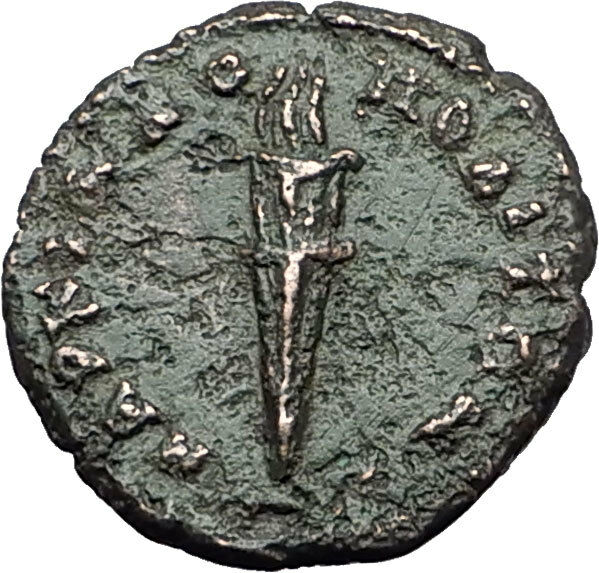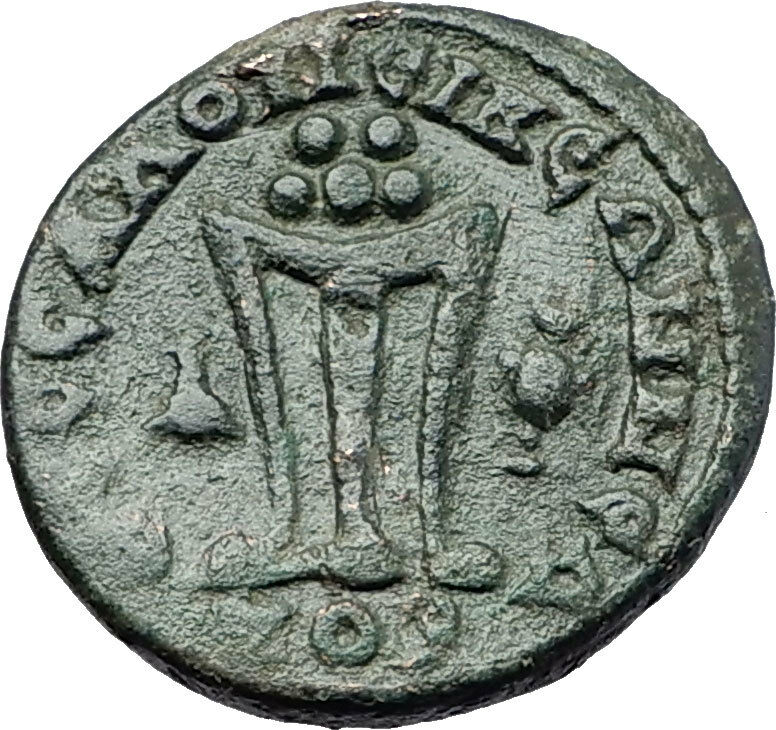|
Caracalla
–
Roman Emperor
: 198-217 A.D. –
Bronze 17mm (2.83 grams) of
Marcianopolis
in Moesia Inferior
Laureate head right.
MAPKIANOΠOΛEITΩN, Nude
Hermes standing facing, holding caduceus and money pouch.
You are bidding on the exact item pictured,
provided with a Certificate of Authenticity and Lifetime Guarantee of
Authenticity.
The caduceus from
Greek
“herald’s staff” is the staff carried by
Hermes
in
Greek mythology
. The same staff was also borne
by heralds in general, for example by
Iris
, the messenger of
Hera. It is a short staff entwined by two
serpents
, sometimes surmounted by wings. In
Roman iconography it was often depicted being carried in the left hand of
Mercury
, the messenger of the gods, guide of
the dead and protector of merchants, shepherds, gamblers, liars, and thieves.
As a symbolic object it represents Hermes (or the Roman Mercury), and by
extension trades, occupations or undertakings associated with the god. In later
Antiquity
the caduceus provided the basis for
the
astrological symbol
representing the
planet Mercury
. Thus, through its use in
astrology
and
alchemy
, it has come to denote the
elemental metal
of the same name.
By extension of its association with Mercury/Hermes, the caduceus is also a
recognized symbol of commerce and negotiation, two realms in which balanced
exchange and reciprocity are recognized as ideals. This association is ancient,
and consistent from the Classical period to modern times. The caduceus is also
used as a symbol representing printing, again by extension of the attributes of
Mercury (in this case associated with writing and eloquence).
The caduceus is sometimes mistakenly used
as a symbol of medicine and/or medical practice
,
especially in
North America
, because of widespread confusion
with the traditional medical symbol, the
rod of Asclepius
, which has only a single snake
and no wings.
The term kerukeion denoted any herald’s staff, not necessarily
associated with Hermes in particular.
Lewis Richard Farnell
(1909) in his study of
the cult of Hermes assumed that the two snakes had simply developed out of
ornaments of the shepherd’s crook used by heralds as their staff. This view has
been rejected by later authors pointing to parallel iconography in the Ancient
Near East. It has been argued that the staff or wand entwined by two snakes was
itself representing a god in the pre-anthropomorphic era. Like the
herm
or
priapus
, it would thus be a predecessor of the
anthropomorphic Hermes of the classical era.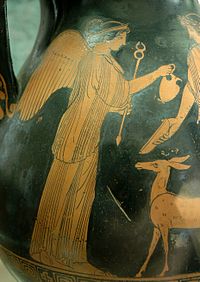
Ancient Near East
William Hayes Ward
(1910) discovered that
symbols similar to the classical caduceus sometimes appeared on
Mesopotamian cylinder seals
. He suggested the
symbol originated some time between 3000 and 4000 BCE, and that it might have
been the source of the Greek caduceus.[10]
A.L. Frothingham incorporated Dr. Ward’s research into his own work, published
in 1916, in which he suggested that the prototype of Hermes was an “Oriental
deity of Babylonian extraction” represented in his earliest form as a snake god.
From this perspective, the caduceus was originally representative of Hermes
himself, in his early form as the Underworld god
Ningishzida
, “messenger” of the “Earth Mother”.
The caduceus is mentioned in passing by
Walter Burkert
[12]
as “really the image of copulating snakes taken over from Ancient Near Eastern
tradition”.
In Egyptian iconography, the
Djed pillar is depicted as containing a snake in a frieze of the
Dendera Temple complex
.
The rod of Moses
and the
brazen serpent
are frequently compared to the
caduceus, especially as Moses is acting as a messenger of God to the
Pharaoh
at the point in the narrative where he
changes his staff into a serpent.[13]
Classical antiquity
Mythology
The
Homeric hymn
to Hermes relates how Hermes
offered his lyre fashioned from a tortoise shell as compensation for the
cattle he stole
from his half brother
Apollo
. Apollo in return gave Hermes the
caduceus as a gesture of friendship. The association with the serpent thus
connects Hermes to Apollo
, as later the serpent was associated
with Asclepius
, the “son of Apollo”. The association
of Apollo with the serpent is a continuation of the older
Indo-European
dragon
-slayer motif.
Wilhelm Heinrich Roscher
(1913) pointed out
that the serpent as an attribute of both Hermes and Asclepius is a variant of
the “pre-historic semi-chthonic serpent hero known at Delphi as
Python
“, who in classical mythology is slain by
Apollo.
One Greek myth of origin
of the caduceus is part of the
story of Tiresias
, who found two snakes copulating and
killed the female with his staff. Tiresias was immediately turned into a woman,
and so remained until he was able to repeat the act with the male snake seven
years later. This staff later came into the possession of the god Hermes, along
with its transformative powers.
Another myth suggests that Hermes (or Mercury) saw two serpents entwined in
mortal combat. Separating them with his wand he brought about peace between
them, and as a result the wand with two serpents came to be seen as a sign of
peace.
In Rome, Livy
refers to the caduceator who
negotiated peace arrangements under the diplomatic protection of the caduceus he
carried.
Iconography
In some vase paintings ancient depictions of the Greek kerukeion are
somewhat different from the commonly seen modern representation. These
representations feature the two snakes atop the staff (or rod), crossed to
create a circle with the heads of the snakes resembling horns. This old graphic
form, with an additional crossbar to the staff, seems to have provided the basis
for the graphical
sign of Mercury
(☿) used in
Greek astrology
from Late Antiquity.
Use in alchemy
and occultism
As the symbol of both the
planet
and the
metal
named for Mercury, the caduceus became an
important symbol in
alchemy
.
The
crucified serpent
was also revived as an
alchemical symbol for
fixatio
, and
John Donne
(Sermons 10:190) uses
“crucified Serpent” as a title of
Jesus Christ
.
Symbol of commerce
A simplified variant of the caduceus is to be found in dictionaries,
indicating a “commercial term” entirely in keeping with the association of
Hermes with commerce. In this form the staff is often depicted with two winglets
attached and the snakes are omitted (or reduced to a small ring in the middle).
The Customs Service of the former
German Democratic Republic
employed the
caduceus, bringing its implied associations with thresholds, translators, and
commerce, in the service medals they issued their staff.
Misuse as symbol
of medicine
It is relatively common, especially in the United States, to find the
caduceus, with its two snakes and wings, used as a symbol of medicine instead of
the correct rod of Asclepius, with only a single snake. This usage is erroneous,
popularised largely as a result of the adoption of the caduceus as its insignia
by the
US Army medical corps
in 1902 at the insistence
of a single officer (though there are conflicting claims as to whether this was
Capt. Frederick P. Reynolds or Col. John R. van Hoff).
The rod of Asclepius is the dominant symbol for professional healthcare
associations in the United States. One survey found that 62% of professional
healthcare associations used the rod of Asclepius as their symbol. The same
survey found that 76% of commercial healthcare organizations used the Caduceus
symbol. The author of the study suggests the difference exists because
professional associations are more likely to have a real understanding of the
two symbols, whereas commercial organizations are more likely to be concerned
with the visual impact a symbol will have in selling their products.
The initial errors leading to its adoption and the continuing confusion it
generates are well known to medical historians. The long-standing and abundantly
attested historical associations of the caduceus with commerce, theft,
deception, and death are considered by many to be inappropriate in a symbol used
by those engaged in the healing arts. This has occasioned significant criticism
of the use of the caduceus in a medical context.
Marcianopolis, or Marcianople was an ancient Roman city in
Thracia
. It was located at the site of modern
day Devnya
,
Bulgaria
.
The city was so renamed by Emperor
Trajan
after his sister
Ulpia Marciana
, and was previously known as
Parthenopolis. Romans repulsed a
Gothic
attack to this town in
267
(or 268
), during the reign of
Gallienus
.
Diocletian
made it the capital of the
Moesia Secunda
province.
Valens
made it his winter quarters in 368 and
succeeding years, Emperor
Justinian I
restored and fortified it. In 587,
it was sacked by the king of the
Avars
but at once retaken by the Romans. The
Roman army quartered there in 596 before crossing the Danube to assault the
Avars.
Between 893 and 972 it was one of the most important medieval cities in
south-eastern Europe.
Hermes is the great messenger of the gods in
Greek mythology
and additionally as a
guide to the Underworld
. Hermes was born on
Mount Cyllene
in Arcadia. An
Olympian god
, he is also the patron of
boundaries and of the travelers who cross them, of
shepherds
and
cowherds
, of the cunning of thieves and liars,
of orators and wit, of literature and poets, of athletics and sports, of weights
and measures, of invention, and of commerce in general. His symbols include the
tortoise, the rooster, the winged sandals, the winged hat, and the
caduceus
(given to him by Apollo in exchange
for the lyre).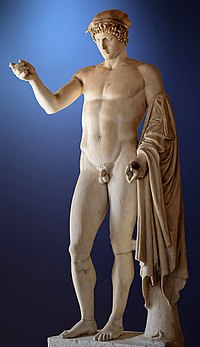
Symbols of Hermes were the palm tree, turtle, rooster, goat, the number four,
several kinds of fish, incense. Sacrifices involved honey, cakes, pigs, goats,
and lambs.
In the Roman adaptation of the Greek religion (see
interpretatio romana
), Hermes was
identified with the Roman god
Mercury
, who, though inherited from the
Etruscans
, developed many similar
characteristics, such as being the patron of commerce.
The
Homeric hymn
to Hermes invokes him as the one
“of many shifts (polytropos), blandly cunning, a robber, a cattle driver,
a bringer of dreams, a watcher by night, a thief at the gates, one who was soon
to show forth wonderful deeds among the deathless gods.”
He protects and takes care of all the travelers, miscreants, harlots, old
crones
and thieves that pray to him or cross
his path. He is athletic and is always looking out for runners, or any athletes
with injuries who need his help.
Hermes is a messenger from the gods to humans, sharing this role with
Iris
. An interpreter who bridges the boundaries
with strangers is a hermeneus. Hermes gives us our word “hermeneutics“,
the study and theory of interpretation. In Greek a lucky find was a hermaion.
Hermes delivered messages from Olympus to the mortal world. He wears shoes with
wings on them and uses them to fly freely between the mortal and immortal world.
Hermes was the second youngest of the
Olympian gods
, being born before
Dionysus
.
Hermes, as an inventor of fire, is a parallel of the
Titan
,
Prometheus
. In addition to the
lyre, Hermes was believed to have invented many types of racing and
the sports of wrestling and boxing, and therefore was a patron of athletes.
According to prominent
folklorist
Yeleazar Meletinsky
, Hermes is a deified
trickster
. Hermes also served as a
psychopomp
, or an escort for the dead to help
them find their way to the
afterlife
(the
Underworld
in the Greek myths). In many Greek
myths, Hermes was depicted as the only god besides
Hades
,
Persephone
,
Hecate
, and
Thanatos
who could enter and leave the
Underworld without hindrance.
Hermes often helped travelers have a safe and easy journey. Many Greeks would
sacrifice to Hermes before any trip.
In the fully-developed Olympian pantheon, Hermes was the son of
Zeus and the
Pleiade
Maia
, a daughter of the Titan
Atlas
. Hermes’ symbols were the
cock
and the
tortoise
, and he can be recognized by his purse
or pouch, winged sandals
,
winged cap
, and the herald’s staff, the
kerykeion
. The night he was born he slipped
away from Maia and stole his elder brother
Apollo
‘s cattle.
Caracalla 198-217 A.D.
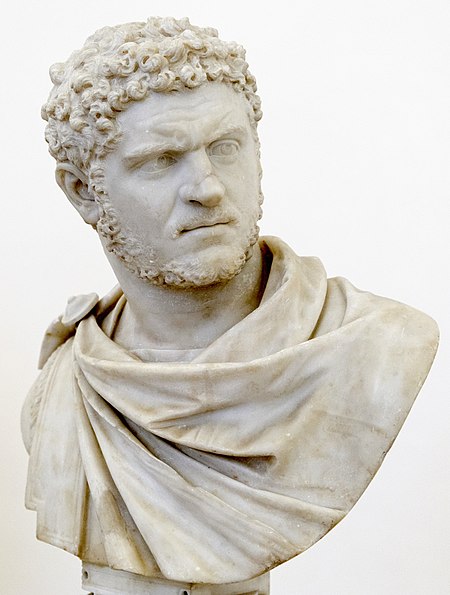
Caesar:
195-198 A.D. (under
Septimius Severus
)
Augustus: 198-217 A.D. (198-209 A.D. with
Septimius Severus
) (209-211 A.D. with
Septimius Severus
and
Geta
) (211 A.D. with
Geta
) (211-217 A.D. Sole Reign)
Son of
Septimius Severus
and
Julia Domna
| Brother of
Geta
| Husband of
Plautilla
| Nephew of
Julia Maesa
| Cousin of
Julia Soaemias
and
Julia Mamaea
|
Caracalla (Latin:
Marcus Aurelius Severus Antoninus Augustus;4
April 188 – 8 April 217) was
Roman emperor
from 198 to 217 The eldest son of
Septimius Severus
, for a short time he ruled
jointly with his younger brother
Geta
until he had him murdered in 211.
Caracalla is remembered as one of the most notorious and unpleasant of emperors
because of the massacres and persecutions he authorized and instigated
throughout the Empire.
Caracalla’s reign was also notable for the
Constitutio Antoniniana
(also called the
Edict of Caracalla), granting
Roman citizenship
to all freemen throughout the
Roman Empire
, which according to historian
Cassius Dio
, was done for the purposes of
raising tax revenue. He is also one of the emperors who commissioned a large
public bath-house (thermae)
in Rome. The remains of the
Baths of Caracalla
are still one of the major
tourist attractions of the Italian capital.
Early life
Caracalla, of mixed
Punic
–Roman
and Syrian
descent, was born Lucius Septimius
Bassianus in Lugdunum
,
Gaul (now Lyon
,
France
), the son of the later Emperor Septimius
Severus and
Julia Domna
. At the age of seven, his name was
changed to Marcus Aurelius Septimius Bassianus Antoninus to create a connection
to the family of the philosopher emperor
Marcus Aurelius
. He was later given the
Caracallanickname
,
which referred to the Gallic hooded tunic he habitually wore and which he made
fashionable.
Reign (211)
Murder of brother
(211)
His father died in 211 at
Eboracum
(now
York) while on campaign in northern Britain. Caracalla was present
and was then proclaimed emperor by the troops along with his brother
Publius Septimius Antoninus Geta
. Caracalla
suspended the
campaign in Caledonia
and soon ended all
military activity, as both brothers wanted to be sole ruler thus making
relations between them increasingly hostile. When they tried to rule the Empire
jointly they actually considered dividing it in halves, but were persuaded not
to do so by their mother.
Then in December 211 at a reconciliation meeting arranged by their mother
Julia, Caracalla had Geta assassinated by members of the Praetorian Guard loyal
to himself, Geta dying in his mother’s arms. Caracalla then persecuted and
executed most of Geta’s supporters and ordered a
damnatio memoriae
pronounced by the Senate
against his brother’s memory.
Geta’s image was simply removed from all coinage, paintings and statues,
leaving a blank space next to Caracalla’s. Among those executed were his former
cousin-wife
Fulvia Plautilla
, his unnamed daughter with
Plautilla along with her brother and other members of the family of his former
father-in-law
Gaius Fulvius Plautianus
. Plautianus had
already been executed for alleged treachery against emperor Severus in 205.
About the time of his accession he ordered the
Roman currency
devalued, the silver purity of
the denarius
was decreased from 56.5% to 51.5%, the
actual silver weight dropping from 1.81 grams to 1.66 grams – though the overall
weight slightly increased. In 215 he introduced the
antoninianus
, a “double denarius” weighing
5.1 grams and containing 2.6 grams of silver – a purity of 52%.
In the Roman provinces
In 213, Caracalla went north to the German frontier to deal with the
Alamanni
tribesmen who were raiding in the
Agri Decumates
. The Romans did defeat the
Alamanni in battle near the river
Main
, but failed to win a decisive victory over
them. After a peace agreement was brokered and a large bribe payment given to
the invaders, the Senate conferred upon him the empty title of Germanicus
Maximus. He also acquired the surname Alemannicus at this time. The
following year the tyrant traveled to the East, to Syria and Egypt never to
return to Rome.
Gibbon
in his work describes Caracalla as “the
common enemy of mankind”. He left the capital in 213, about a year after the
murder of Geta, and spent the rest of his reign in the provinces, particularly
those of the East. He kept the Senate and other wealthy families in check by
forcing them to construct, at their own expense, palaces, theaters, and places
of entertainment throughout the periphery. New and heavy taxes were levied
against the bulk of the population, with additional fees and confiscations
targeted at the wealthiest families.
When the inhabitants of
Alexandria
heard Caracalla’s claims that he had
killed Geta in self-defense, they produced a satire mocking this as well as
Caracalla’s other pretensions. In 215, Caracalla savagely responded to this
insult by slaughtering the deputation of leading citizens who had unsuspectingly
assembled before the city to greet his arrival, and then unleashed his troops
for several days of looting and plunder in Alexandria. According to historian
Cassius Dio, over 20,000 people were killed.[citation
needed]
Domestic Roman policy
Affiliation with
the army
During his reign as emperor, Caracalla raised the annual pay of an average
legionary to 675
denarii
and lavished many benefits on the
army which he both feared and admired, as instructed by his father Septimius
Severus who had told him on his deathbed to always mind the soldiers and ignore
everyone else. Caracalla did manage to win the trust of the military with
generous pay rises and popular gestures, like marching on foot among the
ordinary soldiers, eating the same food, and even grinding his own flour with
them.
With the soldiers, “He forgot even the proper dignity of his rank,
encouraging their insolent familiarity,” according to Gibbon. “The vigour of the
army, instead of being confirmed by the severe discipline of the camps, melted
away in the luxury of the cities.”
His official portraiture marks a break with the detached images of the
philosopher–emperors who preceded him: his close-cropped haircut is that of a
soldier, his pugnacious scowl a realistic and threatening presence. This rugged
soldier–emperor iconic archetype was adopted by most of the following emperors
who depended on the support of the troops to rule, like his eventual successor
Maximinus Thrax
.
Seeking to secure his own legacy, Caracalla also commissioned one of Rome’s
last major architectural achievements, the
Baths of Caracalla
, the 2nd largest public
baths ever built in ancient Rome. The main room of the baths was larger than
St. Peter’s Basilica
, and could easily
accommodate over 2,000 Roman citizens at one time. The bath house opened in 216,
complete with libraries, private rooms and outdoor tracks. Internally it was
lavishly decorated with gold-trimmed marble floors, columns, mosaics and
colossal statuary.
Edict of
Caracalla (212)
The
Constitutio Antoniniana
(Latin: “Constitution
[or Edict] of Antoninus”) (also called Edict of Caracalla) was an edict
issued in 212 by Caracalla which declared that all free men in the Roman Empire
were to be given full Roman citizenship and all free women in the Empire were
given the same rights as Roman women.
Before 212, for the most part only inhabitants of Italia held full Roman
citizenship. Colonies of Romans established in other provinces, Romans (or their
descendants) living in provinces, the inhabitants of various cities throughout
the Empire, and small numbers of local nobles (such as kings of client
countries) held full citizenship also. Provincials, on the other hand, were
usually non-citizens, although many held the
Latin Right
.
The Roman Historian
Cassius Dio
contended that the sole motivation
for the edict was a desire to increase state revenue.At the time aliens did not
have to pay most taxes that were required of citizens, so although nominally
Caracalla was elevating their legal status, he was more importantly expanding
the Roman tax base. The effect of this was to remove the distinction that
citizenship had held since the foundation of Rome and as such the act had a
profound effect upon the fabric of Roman society.
War with Parthia
According to the historian Herodian, in 216, Caracalla tricked the Parthians
into believing that he accepted a marriage and peace proposal, but then had the
bride and guests slaughtered after the wedding celebrations. The thereafter
ongoing conflict and skirmishes became known as the
Parthian war of Caracalla
.
Assassination (217)
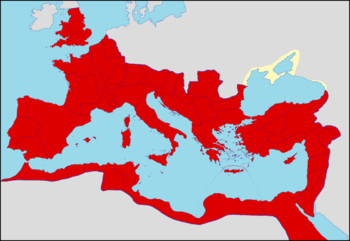
The Roman Empire during the reign of Caracalla.
While travelling from
Edessa
to continue the war with
Parthia
, he was assassinated while urinating at
a roadside near
Carrhae
on 8 April 217 (4 days after his 29th
birthday), by Julius Martialis, an officer of his personal bodyguard.
Herodian
says that Martialis’ brother had been
executed a few days earlier by Caracalla on an unproven charge; Cassius Dio, on
the other hand, says that Martialis was resentful at not being promoted to the
rank of centurion. The escort of the emperor gave him privacy to relieve
himself, and Martialis then ran forward and killed Caracalla with a single sword
stroke. While attempting to flee, the bold assassin was then quickly dispatched
by a Scythian archer of the Imperial Guard.
Caracalla was succeeded by his
Praetorian Guard Prefect
,
Macrinus
, who (according to Herodian) was most
probably responsible for having the emperor assassinated.
His nickname
According to
Aurelius Victor
in his Epitome de Caesaribus,
the agnomen
“Caracalla” refers to a Gallic
cloak
that Caracalla adopted as a personal
fashion, which spread to his army and his court. Cassius Dio and the
Historia Augusta
agree that his nickname
was derived from his cloak, but do not mention its country of origin.
Legendary king of
Britain
Geoffrey of Monmouth
‘s legendary
History of the Kings of Britain
makes
Caracalla a king of Britain, referring to him by his actual name “Bassianus”,
rather than the nickname Caracalla. In the story, after Severus’s death the
Romans wanted to make Geta king of Britain, but the Britons preferred Bassianus
because he had a British mother. The two brothers fought a battle in which Geta
was killed and Bassianus succeeded to the throne. He ruled until he was betrayed
by his Pictish
allies and overthrown by
Carausius
, who, according to Geoffrey, was a
Briton, rather than the historically much later
Menapian
Gaul that he actually was.
|











